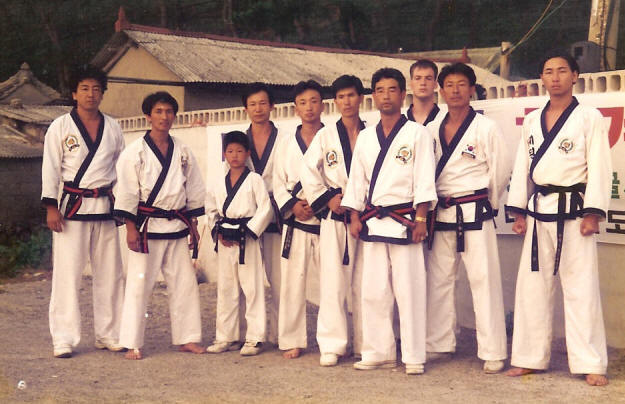Training in Korea
Part 5 of 5
By
Master Todd Huddleston - 8th Dan
Yonsei Martial Arts Academy, New Orleans, LA
Etiquette and Protocol
When it comes to
training in Korea, one cannot separate etiquette from the physical
aspects of training. Etiquette is training and training is etiquette.
This comes from the dominant Confucianism philosophy that is ingrained
in Korean culture. First and foremost, I had to be accepted to train at
the headquarters school. That
meant I couldn't just walk off the street and announce I was going to
start there next week. I had to know someone who knew the head master
at headquarters who would introduce me to him. After meeting with the
master, he would then decide if I could train or not. There was no
other way for me to train there than this.
Fortunately, I did know someone who had already trained there
who was able to set up a meeting for me. I went there on a Saturday, and
was introduced to the head master. He looked at my black belt ID cards
and, as is always done in Korea, asked who my master was. I answered, but no one knew
him since he
was not a current member of the Korean Soo Bak Do Association or the U.S. Soo Bahk Do
Association. This proved to be a
big problem since there was no way to prove if my rank was legitimate. If my master was someone they knew and in good standing with
their organization, I would more than likely be welcomed. If not, then
things were difficult, which was my situation.
Soon afterwards, there
was a lot of discussion about me, and due to the language barrier I wasn't sure what was being said. What saved me was
a name on my first-degree black belt ID card. (My 2nd degree
and 3rd degree cards were different.) The master at the
headquarters school knew the master's name that was on the card, who was the president of the organization that we
were supposedly a part of, and he called him on the spot. After confirming that my
instructor was a Tang Soo Do master they
knew, I was accepted to the school. If that name hadn't been
there, I would not have been allowed to train there. However, my dilemma did not end there
since the head master
then wanted a letter from my instructor asking his permission for me to train at
headquarters. He yelled at me every day until he received the
letter, which I had to fly back to the U.S. to get because my master did
not send one. I didn't know it would be that difficult but that was the
protocol in the "land
of the morning calm."
Proper etiquette was
observed at all times at the headquarters school. When a
student walked into the dojang he had to bow to the Korean flag. You
also had to bow to a senior student who might be there. Students were
also expected to go to the master's office and then bow to him as well, to let
him know that you were there. When a student left, he had to go to the
office and bow to say goodbye.
When you handed things
to others there was a certain way to do so. Anything other then the
correct, respectful way was unacceptable. Once, after coming back from
vacation and arriving late, I didn't bow and say
hello to the master when I arrived. He made it a point to
mention this to all the other students after class in my presence, being
sure to emphasize that this was not right, and he ordered them not to do
the same. Even if you were leaving the school forever, proper etiquette
dictated seeing the master, giving him a gift and thanking him for
his teaching.
This is what made Tang
Soo Do training in Korea
special.
Final Thoughts
What I have written is
just a small sample of my experiences training in Korea. There were many
other challenges after all is
said and done, I was made a better person and a better martial artist
because of it. My eternal gratitude goes to Master Han Chi Sup who made
me earn everything I gained while I was there, and I still am benefiting from his
teachings.

Part 1 -
Part 2 -
Part 3 -
Part 4
-
Part 5